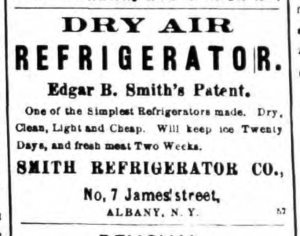 For what seems to be a brief period right around 1876, the Smith Refrigerator Company of No. 7 (later No. 12) James Street in Albany manufactured a dry air refrigerator, essentially a somewhat more sophisticated ice box, that gathered a little bit of attention and a national award, and then (as far as we can tell) disappeared. This ad from 1876 proclaims that Smith’s patented refrigerator was one of the simplest refrigerators made. “Dry, Clean, Light and Cheap. Will keep ice Twenty Days, and fresh meat Two Weeks.”
For what seems to be a brief period right around 1876, the Smith Refrigerator Company of No. 7 (later No. 12) James Street in Albany manufactured a dry air refrigerator, essentially a somewhat more sophisticated ice box, that gathered a little bit of attention and a national award, and then (as far as we can tell) disappeared. This ad from 1876 proclaims that Smith’s patented refrigerator was one of the simplest refrigerators made. “Dry, Clean, Light and Cheap. Will keep ice Twenty Days, and fresh meat Two Weeks.”
An 1890 guide by the Baldwin Manufacturing Company gives us an idea of how a dry air refrigerator worked:
“The Cold Air falls to the LOWEST point in Refrigerator through an AIR DUCT, when it enters the Provision Compartment, displacing the LIGHTER AIR, forcing it upward through the Provision Compartment to its highest point, thence escaping through an AIR DUCT into TOP of Ice Room.” (Thus presaging both modern refrigeration and modern attitudes toward capitalization.)
The Smith Refrigerator was awarded twice at the Centennial International Exhibition in Philadelphia in 1876, in the categories of “Apparatus of Heating, Lighting, etc.” and “Agricultural Machines, Implements of Agriculture, etc.,” and that accomplishment was noted in the Albany papers. On August 11, 1876, the Albany Express featured this article of interest:
“The French Baron Seilliere, who is now at New York with his elegant yacht Surprise, has been looking after that indispensible article of household comfort, a good refrigerator, and after thoroughly canvassing the matter, has ordered of the Smith Refrigerator Co. of this city, through their New York agents, Messrs. Newman & Capron, one of their large size dry air refrigerators of extra finish and style. From the success of this new invention we think the Baron will be Well pleased with his purchase.”
 The company advertised regularly in 1876 and 1877, and in that latter we find evidence that they have moved beyond the household refrigerator to offer hotel refrigerators, refrigerator rooms, beer coolers, and refrigerator cars. In August 1876, they suffered a fire at a warehouse they used, owned by J.W. Osborn, when an entire block between DeWitt and Lawrence Streets (bounded by the Canal and the railroad) burned; their loss was $500 and tools owned by employees.
The company advertised regularly in 1876 and 1877, and in that latter we find evidence that they have moved beyond the household refrigerator to offer hotel refrigerators, refrigerator rooms, beer coolers, and refrigerator cars. In August 1876, they suffered a fire at a warehouse they used, owned by J.W. Osborn, when an entire block between DeWitt and Lawrence Streets (bounded by the Canal and the railroad) burned; their loss was $500 and tools owned by employees.
But beyond that, we find no further mention of the Smith Refrigerator Company.

Leave a Reply